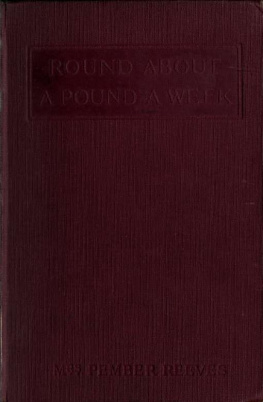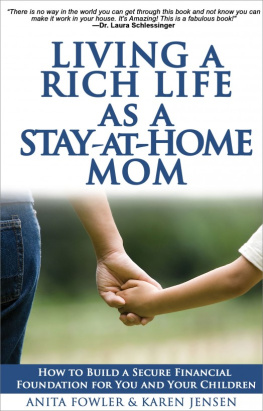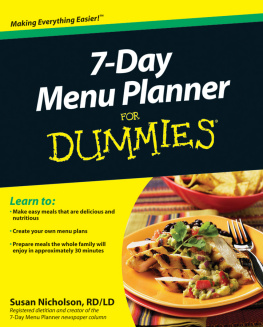This book made available by the Internet Archive.
TO MY FELLOW-WORKER
E. C L.

PREFACE
I AM glad to take this opportunity to acknowledge the use I have made of a manuscript written by Mrs. Charlotte Wilson, Hon. Secretary of the Fabian Women's Group. The manuscript was founded on a lecture, entitled "The Economic Disintegration of the Family," delivered by Mrs. Wilson to the Fabian Society in June, 1909. Not only ideas contained in the lecture, but also some of the wording of the manuscript, have been used in the last two chapters.
I wish also to thank Dr. Ethel Bentham for the invaluable professional service rendered by her during the five years of the investigation.
M. S. REEVES.
ROUND ABOUT A POUND A WEEK
CHAPTER I
THE DISTRICT
TAKE a tram from Victoria to Vauxhall Station. Get out under the railway arch which faces Vauxhall Bridge, and there you will find Ken-nington Lane. The railway arch roofs in a din which reduces the roar of trains continually passing overhead to a vibrating, muffled rumble. From either end of the arch comes a close procession of trams, motor-buses, brewers' drays, coal-lorries, carts filled with unspeakable material for glue factory and tannery, motor-cars, coster-barrows, and people. It is a stopping-place for tramcars and motor-buses; therefore little knots of agitated persons continually collect on both pathways, and dive between the vehicles and descending passengers in order to board the particular bus or tram they desire. At rhythmic intervals all traffic through the arch is suspended to allow a flood of trams, buses, drays, and vans, to surge and rattle and bang across the opening of the archway which faces the river.
? THE DISTRICT
At the opposite end there is no cross-current. The trams slide away to the right towards the Oval. In front is Kennington Lane, and to the left, at right angles, a narrow street connects with Vauxhall Walk, leading farther on into Lambeth Walk, both locally better known as The Walk. Such is the western gateway to the district stretching north to Lambeth Road, south to Lansdowne Road, and east to Wai worth Road, where live the people whose lives form the subject of this book.
They are not the poorest people of the district. Far from it! They are, putting aside the tradesmen whose shops line the big thoroughfares such as Kennington Road or Kennington Park Road, some of the more enviable and settled inhabitants of this part of the world. The poorest people the river-side casual, the workhouse in-and-out, the bar-room loafer are anxiously ignored by these respectable persons whose work is permanent, as permanency goes in Lambeth, and whose wages range from i8s. to 305. a week.
They generally are somebody's labourer, mate, or handyman. Painters' labourers, plumbers' labourers, builders' handymen, dustmen's mates, printers' labourers, potters' labourers, trouncers for carmen, are common amongst them. Or they may be fish-fryers, tailors' pressers, feather-cleaners' assistants, railway-carriage washers, employees of dust contractors, carmen for Borough Council contractors, or packers of various
descriptions. They are respectable men in full work, at a more or less top wage, young, with families still increasing, and they will be lucky if they are never worse off than they now are. Their wives are quiet, decent, " keep themselves-to-themselves " kind of women, and the children are the most punctual and regular scholars, the most clean-headed children of the poorer schools in Kennington and Lambeth.
The streets they live in are monotonously and drearily decent, lying back from the main arteries, and with little traffic other than a stray barrel-organ, a coal-lorry selling by the hundredweight sack, or a taxi-cab going to or from its driver's dinner at home. At certain hours in the day before morning school, at midday, and after four o'clock these narrow streets become full of screaming, running, shouting children. Early in the morning men come from every door and pass out of sight. At different times during the evening the same men straggle home again. At all other hours the street is quiet and desperately dull. Less ultra-respectable neighbourhoods may have a certain picturesqueness, or give a sense of community of interest or of careless comradeship, with their untidy women chatting in the doorways and their unoccupied men lounging at the street corners; but in these superior streets a kind of dull aloofness seems to be the order of the day.
The inhabitants keep themselves to themselves, and watch the doings of the other people from
behind window curtains, knowing perfectly that every incoming and outgoing of their own is also jealously recorded by critical eyes up and down the street. A sympathetic stranger walking the length of one of these thoroughfares feels the atmosphere of criticism. The rent-collector, the insurance agent, the coal-man, may pass the time of day with worn women in the doorways, but a friendly smile from the stranger receives no response. A weekly caller becomes the abashed object of intense interest on the part of everybody in the street, from the curious glances of the greengrocer's lady at the corner to the appraising stare of the fat little baker who always manages to be on his doorstep across the road. And everywhere along the street is the visitor conscious of eyes which disappear from behind veiled windows. This consciousness accentuates the dispiriting outlook.
The houses are outwardly decenttwo stories of grimy brick. The roadway is narrow, but on the whole well kept, and on the pavement outside many doors there is to be noticed, in a greater or less condition of freshness, a semicircle of hearthstone, which has for its radius the length of the housewife's arm as she kneels on the step. In some streets little paved alley-ways lead behind the front row of houses, and twist and turn among still smaller dwellings at the backdwellings where the front door leads downwards into a room instead of upwards into a passage. Dis
tricts of this kind cover dreary acres the same little two-story house, with or without an inconceivably drearier basement, with the same kind of baker's shop at the corner faced by the same kind of greengrocer's shop opposite. The ugly, constantly-recurring school buildings are a relief to the spirit oppressed by the awful monotony.
The people who live in these places are not really more like one another than the people who live in Belgrave Square or South Kensington. But there is no mixture of rich and poor, no startling contrast, no crossing-sweeper and no super-taxpayer, and the first impression is that of uniformity. As a matter of fact, the characteristics of Mrs. Smith of Kennington and the characteristics of Mrs. Brown who lives next door are more easily to be differentiated by a stranger in the street than are the characteristics of Mrs. Smythe of Bayswater from those of Mrs. Browne who occupies the house next to her.
Mrs. Smith and Mrs. Brown, though they may never be seen by the passer-by, are able to imprint their personality on the street because their ways are open, and meant to be open, to all whom it may concern. Mrs. Smith likes red ochre at her door, in spite of the children's boots messing it all over the floor. Moreover, she likes to cover the big flagstone in front of the door, and two lesser stones, one on each side; she makes the edges coincide with the cracks, and produces a two
















